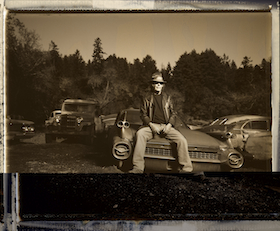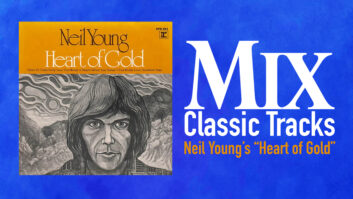
Photo by Danny Clinch
Working with Neil Young can be a wild card, for sure, but it’s probably one of the most exciting gigs a studio engineer can have. John Hanlon has been producing, recording and mixing Young for about 17 years, and to say it never gets boring would be a gross understatement. It’s a thrill. It’s musical genius live on the floor. It’s awesome power on the fly, by the light of the full moon…
Hanlon’s relationship with Young started in 1983, when he and David Briggs, Young’s longtime producer, were working on Trans remixes. Hanlon joined Briggs again in 1990, engineering and mixing Neil Young and Crazy Horse’s magnificent Ragged Glory, and Young has been calling upon Hanlon’s talents ever since.
“When Neil calls me, it’s always out of the blue,” Hanlon says. “His manager, Elliot Roberts, and Neil will call together and say, ‘We need you yesterday.’ Then I just drop everything to go, because I’m working with a real artistic visionary.”
In August 2011, Hanlon got the call to head up from his home in Malibu to Young’s ranch in Northern California. “They told me we’d be working with Crazy Horse and Mark Humphreys,” Hanlon explains. “Mark is Neil’s monitor engineer onstage; he runs the P.A. in the studio. We record everything live, with no headphones. There’s some overdubbing later, but he always goes for the live performance feel. It’s always about the performance with him.”
Hanlon didn’t know in August that the sessions would result in two albums: a heavy, hard-rocking batch of folk songs called Americana, and Psychedelic Pill, a collection of new originals. Hanlon was simply told that the first order of business would be to install a studio that could serve as a working clubhouse for the musicians and a small crew.
“I was to build a studio in one of the houses on the ranch where David Briggs and Tim Mulligan had done American Stars ’n Bars with Neil back in the ’80s,” Hanlon says. “And he wanted to do it 8-track analog, which meant we’d also snapshot to Pro Tools, but he wanted an 8-track setup, in the building they call the ‘white house.’
“First I went up for some preliminary meetings with my assistant engineer, John Hausmann, to lay out the space and check out the acoustics. I purposely didn’t ask how they had set up the room for American Stars ’n Bars. I wanted to feel the vibe in the room without any preconceived notions of copying what they did. That was the 1980s; sounds and amplifiers, and where people’s heads were, would have affected the sound coming off of the instruments and from their souls at that time, anyway. Everything changes.

Recording/mixing engineer John Hanlon at the 12-input Universal Audio “Green Board” and Neve BCM 10 sidecar, in the control room he built in Neil Young’s “white house.”
Photo: Ben Johnson; courtesy Shaky Pictures
“Neil’s other directive was, he wanted to record during full-moon weeks,” Hanlon continues. “That’s when he happens to get creative. That doesn’t mean if he writes a song three weeks after that, I wouldn’t get another call. But this was the gathering point for when and where he wanted to start.”
Young obviously wanted to work in a homey atmosphere; he has a high-end, fully equipped studio, Redwood Digital, on the other side of his ranch, but he chose to track in a furnished house. So, Hanlon set about judiciously paring down the decor in the white house, making enough room in the 35x25x8-foot living room for the musicians and their rigs, but keeping a sofa, stuffed chairs and warm lighting.
“I knew where the moon rose, and the way the house is oriented there’s a huge ceiling-to-floor, wall-to-wall glass window at one end of the room where you could see all the moonlight,” Hanlon says. “I tried putting the drum riser by the glass because there’s also a wooden-slat diffuser there—not an acoustically designed diffuser, but something to keep pool cues from hitting the picture window because there’s normally a pool table in there. But the drums happened to sound best on the far wall opposite that glass wall.”
Hanlon then positioned the rest of the band in relation to the kit, approximating their onstage setup as near as possible. “That’s how they’re most comfortable,” Hanlon says. “That means that from [drummer] Ralph Molina’s perspective, Neil’s rig—which was a ’50s [Fender] Vibralux and ’50s [Fender] Tweed Deluxe—is ‘stage left.’ At stage right is Billy Talbot’s Showman bass cabinet. Normally, to Billy’s right is Frank [Poncho] Sampedro’s rhythm guitar rig, but that wall was not wide enough to accommodate that. So, instead, I put him in this little alcove off the right side of the living room where the original house entrance used to be; that had a little tiled area where the carpet stops. It worked well because I was able to get a little bit of room ambience on him without having bass and everything else build up into his close mics.”
Hanlon installed a control room in the master bedroom of the house, bringing in a 12-input Universal Audio “green board” tube console with a Neve BCM10 sidecar, and a 16-input UA “brass board” mixing desk as well as a Baby Neve monitor board. The 8-track tape machine was an analog 2-inch Studer 827. Hanlon rented a Pro Tools 192/24 system for backup, and as a safety to cover any tracks he might need beyond the 8-track mandate. All of the mics and rack gear in Redwood Digital were made available to Hanlon for the sessions, with one exception:
“On kick drum, I wanted a [Neumann] U47 tube mic,” Hanlon says. “I wanted to record the kit Glyn Johns-style. That means two mics on the kit, and a third in front of the kick drum. I asked for a particular U47 to use on the kick; Neil happens to own two. But it turns out that the one I was asking for happens to be the vocal mic that Neil used on background vocals with Nicolette Larson, Linda Ronstadt and Emmylou Harris as well as his own vocals in his studio acoustic setup. John Nowland, the studio manager over at Redwood Digital, politely informed me that it was not to be used in front of the kick. I ended up settling for a 47 FET that worked well.”

Americana album art.
Hanlon placed a pair of U67s over the rest of Molina’s kit. “There was a 90-degree angle between the two capsules that coincide over the snare. Each of those 67s sat on its own track,” Hanlon says.
On bass, he took a DI and placed another 47 FET; these were combined to one track on the Studer and in Pro Tools. That’s four tracks.
“On guitars—Poncho and Neil, tracks 5 and 6—I mike in a style similar to what I learned from Andy Johns,” Hanlon says. “Andy is one of the greatest engineers in the world. He could get a great sound out of anything. He used to put two Shure 57s or 56s on each guitar cabinet. One would be straight on, and one would be angled to the cone. I find I can get mids and highs from the straight-on mic, and all the bottom end from the side mic.”
On Sampedro’s guitar rig, Hanlon used two Shure SM57s, plus an AKG C12A to capture the ambience of that tiled alcove. “The microphones on Neil’s rig were the same type of setup,” Hanlon says. “I had two 57s on each of his two guitar amps. I could use whichever amp I wanted, or both.”

Psychedelic Pill album art.
Hanlon put up Neumann KMS140 vocal mics for Young (track 7), as well as for Talbot and Sampedro, and a KMS150 for Molina. Track 8 shared the room mics and Ralph Molina’s vocal mic. But for those who are keeping score, at this point Hanlon went over the 8-track limit. “Poncho and Billy’s vocals had to go strictly to Pro Tools,” Hanlon says. “I had a few other Pro Tools-only tracks. One is what I call the subkick. I sent the kick drum mic, the 47 FET, to a small subwoofer that I had miked with an 87 with a foam pad over it; it reinforces the kick drum into the room. This is very low-frequency, but it helps modulate the mids and highs into the room mics for a better room sound, and it helps Billy Talbot, the bass player, stay in sync with the drums. Since we don’t use headphones, the tighter I can get the drummer and bass player to play together, the better the whole room’s going to sound.”
Another Pro Tools-only track was what Hanlon calls the “Briggs compressor,” after Young’s former producer: “This was David Briggs’ old RCA mono compressor, to which I sent a combination of the kick and the two U67 mics on the drums via a bus on the BCM10 Neve,” he says. “You get a single track of this mono, smashed, compressed, fat drum sound.
“So, everything we absolutely had to have—the core band sounds—was on those eight analog tracks. I kept the subkick and the Briggs compressor separate, because if Neil decided less is more and he didn’t want me to use them during mixdown, I could leave them out.”
Still, after all the care and wisdom that went into the studio plan, Hanlon did not know what music he was going to hear by the light of an October 2011 full moon when the sessions began: “Neil may have talked to the band about the material, but if he did I wasn’t present. I didn’t know we were doing folk songs until we got in there.”

From left: Drummer Ralph Molina, guitarist Frank “Poncho” Sampdero, Neil Young, and bass player Billy Talbot.
Photo: Julie Gardner
But even if he had been prepped about the Americana sessions, it would have been hard for the producer/engineer to envision Young and Crazy Horse’s gorgeous and brutal interpretations of chestnuts like “Oh Susannah,” “Clementine” and “Jesus’ Chariot (She’ll Be Comin’ Round the Mountain).” The screaming guitars, the thunderous drums, Young’s plaintive voice… on songs we all sang in grade school. It’s unsettling, in a good way.
The Americana sessions took place in those full-moon weeks, October through December 2011. By December, Hanlon was recording some overdubs for the record, including children’s choir sessions at EastWest Studios (Hollywood). After Christmas, he began mixing Americana on the Neve 8078 in Redwood Digital. Then in January, he was asked to be ready for more recording. Full-moon weeks during the next few months would see the band tracking songs with massive instrumental jams that would be edited down into brand-new songs—though some were edited more than others.
The first track on the album, “Drifting Back,” for example, started as a 32-minute take. “That performance happened on a Saturday,” Hanlon recalls. “I got up early Sunday morning and called Neil and said, ‘I think you have something here,’ and went over and played it for him on a CD. We mapped all this stuff out in terms of structure—identifiable choruses and verses and B sections—while listening to these parts on a little blaster, sitting in the entranceway of his home, and marveled at what he had.”
“Drifting Back” got edited down for the release, but only by about six minutes. There are also a couple of 16-plus-minute songs on the album, as well as several more concise tunes. The nine tracks on Pill fill two discs; they’re very different in shape and intent from Americana, and sonically somewhat different as well.
“There were important differences between the Americana sessions and the Psychedelic Pill sessions,” Hanlon says. “On Americana, Billy Talbot had a Daking direct box that had gain available in it; we were using that as a preamp to his Showman bass amp. With that DI, even when no gain was selected on the pot on the front, it still affected the sound, and it was a pleasant sound. On Psychedelic Pill, he switched to a Sal Trentino active direct box.
“Another change was, Neil stopped using the amp setup he’d had; he went to a modified ’50s Tweed Deluxe with 6L6 tubes and an old Magnatone—the same setup he uses with Crazy Horse on the road. The SPL being thrown into that living room studio was probably 10 to 15 dB louder than what I was dealing with on Americana.”
The sounds that were laid down for Psychedelic Pill are probably closer to what fans will expect from Neil Young and Crazy Horse. But for Hanlon’s part, he’s happy never knowing what to expect from Young—happy with the way the “white house” functioned as a studio; even happy with the limitations imposed by 8-track.
“To me, some of the greatest records are the ones done with the fewest amount of microphones,” Hanlon says. “The sound I like is orchestral. A classical engineer reading this might cringe, but I approach Neil Young and Crazy Horse orchestrally. Musicians playing live together—what a concept.”
Barbara Schultz is a contributing editor to Mix.







